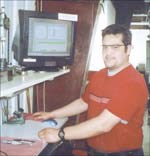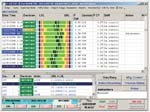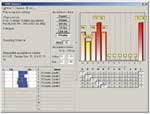Applied Process Intelligence Software Puts World Class In Reach
Automating the process predictability control function control function for this 42-person shop has helped move it toward its goal of being a world-class component parts company. For 2 years, Topcraft Metal Products, Inc. (TMP) has been implementing the comprehensive software system Micronite.
Like many precision turned parts shops, TMP (Hudsonville, Michigan) is in pursuit of zero-defect manufacturing. The shop's president, Kelly Weener, puts it this way: "Zero defect manufacturing is possible, doable and required in our global economy. World-class means using the least amount of time, talent and treasure in the process." Time is reliable and sustainable cycle time. Talent is effective use of machinists and other team members. Treasure is creativity before capital (machines, tools, materials).
Historically, manufacturing was accomplished by relying on a strong plan and an experienced machinist to guide the process. Scrap, rejects and excessive tool wear during the process would be assessed and reacted to.
In today's manufacturing environment, this methodology is simply too costly and erratic to allow a shop to compete. Even SPC, which was a big step forward in controlling variability, has limits beyond identifying special variation causes in a given process.
To help move process control forward, TMP wanted a system that would help its machinist collect and use only the data necessary to help produce quality parts. The thinking is that operators shouldn't be required to collect data not specifically benefiting the run of a given part.
The company's supervisors wanted a process control system in which solid data would definitively identify process issues needing change versus chasing variables not directly causing variation. The company's solution came in the form of knowledge-based process control software. It purchased a system called Micronite by High Tech Research Inc. (Deerfield, Illinois).
The system automates identification, control and monitoring of the variables that comprise a robust manufacturing process. "Understanding, monitoring and controlling the input side of the process equation increases our process reliability and repeatability," Kelly says.
Input Defines Output
In 1993, Kelly bought TMP from its founders. He has continued the company's drive toward innovation by investing in better manufacturing methods. "We don't necessarily jump into every new technology that comes along," he says. "Rather, we try to explore better, more robust methods. Automating our process control system is an example. This has enabled us to get better and more consistent quality from our existing capital equipment and machinists."
In concept, process control is not a difficult thing to understand. The goal has been the same since metalworking began: Make quality parts consistently at the lowest reasonable cost. Process control is about identifying and eliminating variability within a given process.
To illustrate how this works for TMP, Kelly makes a simple drawing. One side of the drawing is a list of inputs that are the numerous variables that control the process.
On the other side of the drawing are outputs, which are parts meeting specifications. In between input and output is the manufacturing/conversion process and feedback loop. The feedback is data collection as it ties into the input parameters. "By sampling and monitoring our outputs based on actual data, outputs, such as Cpk, are automatic," Kelly says. The benefit to the shop is reduced cost. "If you monitor a tool and change or adjust it before the tool is trashed or a dimension is wrong, you've saved the cost of the tool or scrapped parts. It's that simple."
On the company's shop floor, a workstation is positioned to serve four machines. An upper and lower specification limit is entered for each dimension and for the controlling tool for each cutting operation. Based on an imbedded tool wear model, the number of parts being run and other parameters, the software prompts the operator to measure a unit or sample of parts.
Using the measurement feedback (which at TMP are gages wired into the workstation), the software directs the operator to continue, enter an adjustment or change the tool. It also tells the operator how long before the next measurement should be taken and makes changes to the model as new data is collected and analyzed.
This ability to adapt the data collection requirements to what is actually happening in the process is one reason TMP's machinists like this system. If the SPP process is engineered correctly, there is less need for measurement of the outputs.
The decision to automate its process control using software took some time. "What we found with Micronite was a tool that we could use to help us engineer our processes better and standardize our reaction plan on the floor," Kelly explained. "In a nutshell, that's what the system brought to the party for us. It actually evaluates data based on performance expectations and can predict how the process will run by comparing real-time data inputs against those expectations."
Standardizing A Reaction Plan
As the company began to familiarize itself with the analytical capabilities of the new software, it became clear that how the operators reacted to a quality mishap was inconsistent. An experienced operator might read the analysis results one way, whereas a less experienced operator might see things differently. Standardizing process inputs exposed the inconsistency of operators' reaction plans to process deviations.
"Our reaction plans were not consistent with the analysis of the process," Kelly says. "Prior to installing our software, our reaction to a process problem was based on personal experience. This experience, of course, varies. The software standardizes diagnosis of process deviation, which leads to a standardized reaction regime. Standardizing our reaction plans has been a huge benefit of automating the process control function and saves numerous production hours."
Real-Time Analysis
"The key to applying knowledge-based software is the engineering detail that goes into the input items at the beginning of the process," says Emek Schab, TMP's engineering and quality manager. "You need to think through the variables that make up a process."
"For each job, we create a file in the software," he continues. "The file lists the various inputs to be considered in the part processing. These are assigned parameters based on the optimum operation desired and the use of some cutting data embedded in the software. The artificial intelligence then predicts how the process should run using these input parameters. "As the job runs and actual data is collected, the assigned parameters adapt to the operation automatically," Emek explains. "On a new job, for example, the software may ask for several measurements to determine trends within the process. Once there is enough data for a trend analysis, the need for data collection becomes less. On the other hand, if a trend begins to deviate from a predicted expectation, the software will ask for more frequent measurement to determine if a tool needs compensation or changing."
Automating Experience
Regardless of the number of process inputs used for making a part, they fall into one of two categories: independent and dependent variables. Kelly defines independent variables as temperature of the machine, spindle bearing conditions, tool conditions or material variation as examples. Identifying and adjusting for these variables is part of the setup process.
He says a dependent variable might be running a machine without oil, not changing a broken drill or not sharpening a tool in time.
"Experienced machinists know these things instinctively," Kelly says. "What we've tried to do by integrating this process control system into our production is approach it more scientifically by using standard routines to get and keep a process under control. It has brought consistency to how we prepare for manufacturing and resulted in consistent improvement in production of quality parts.
"We know the quality journey has just begun but we are grateful to the people in our industry as well as our TMP team who are creating solutions for today's tough challenges," he adds.
Related Content
Precision Machining Technology Review: December 2023
Production Machining’s December 2023 technology showcase includes some of the latest technology from Sandvik Coromant, Nikon Metrology, The L.S. Starrett Co., Walter USA, Kennametal and SolidCAM.
Read MorePMTS 2023 Product Preview: Measurement
Learn about some of the latest measurement solutions that will be on display at PMTS 2023.
Read MoreShop Finds Value in Simple CMM Programming
Icon-driven programming enables all shopfloor personnel to perform CMM inspection, not just those in the quality department.
Read MoreStreamlining Part Measurement, Data Collection Processes
When collecting measurement data automatically with a wireless data collection system, manual errors can be eliminated ensuring data accuracy and traceability.
Read MoreRead Next
A Tooling Workshop Worth a Visit
Marubeni Citizen-Cincom’s tooling and accessory workshop offers a chance to learn more about ancillary devices that can boost machining efficiency and capability.
Read MoreDo You Have Single Points of Failure?
Plans need to be in place before a catastrophic event occurs.
Read More5 Aspects of PMTS I Appreciate
The three-day edition of the 2025 Precision Machining Technology Show kicks off at the start of April. I’ll be there, and here are some reasons why.
Read More



























